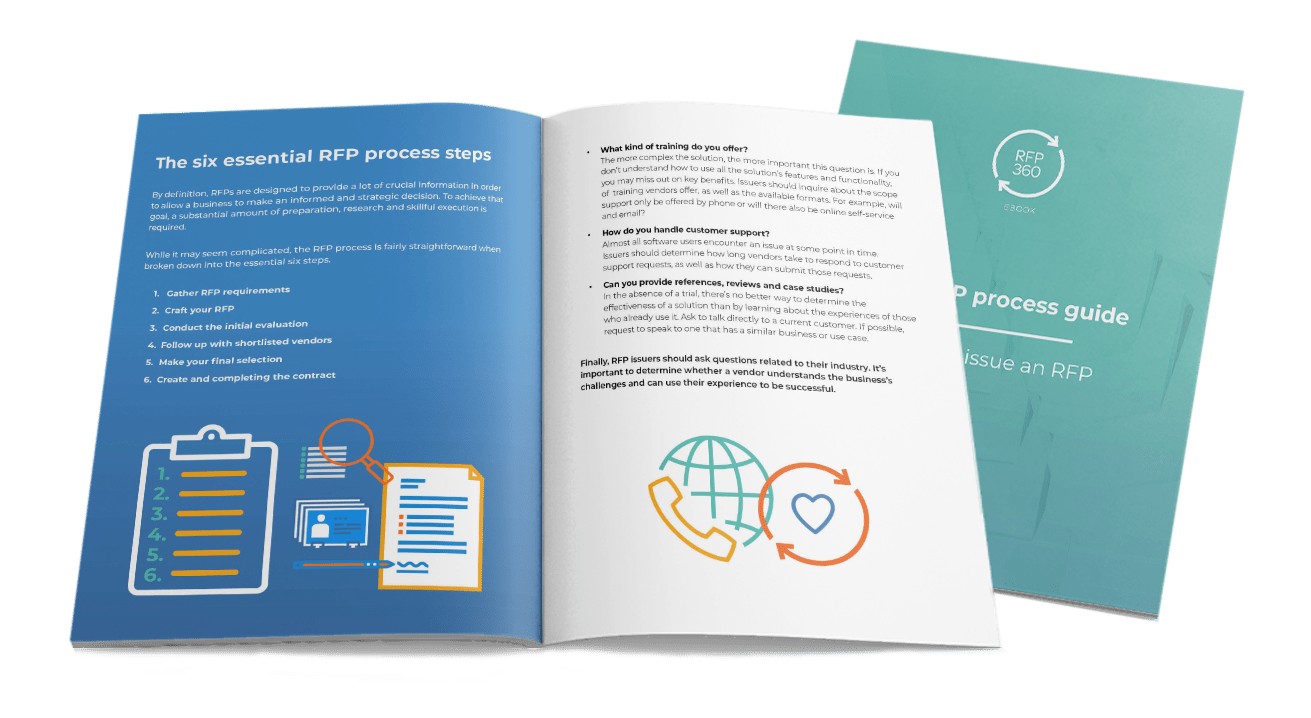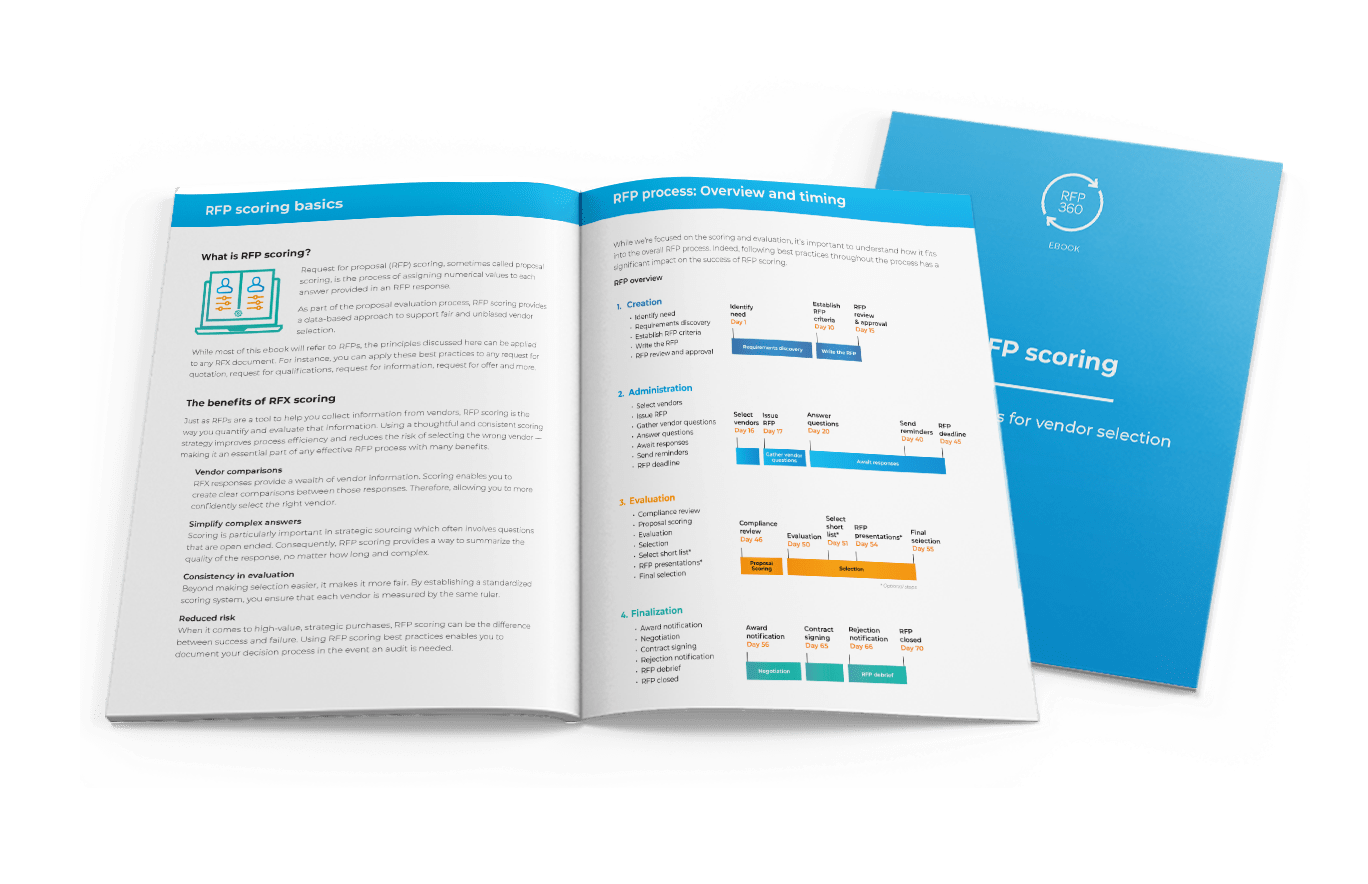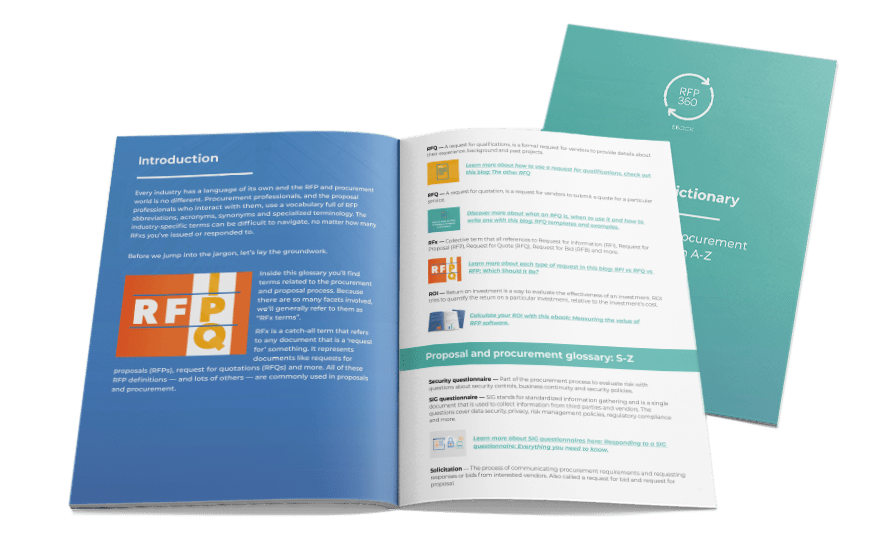Understanding and mastering energy procurement is a unique challenge for many organizations. Indeed, indirect procurement managers must skillfully navigate regulatory compliance, increased demand for sustainable energy and constantly changing rates.
While complex, creating a strategic energy procurement plan and subsequently issuing an energy RFP can deliver tremendous cost savings while reducing risk and increasing reliability. But, before you can start making improvements, you need to know the basics.
In this blog, we’ll strive to make energy procurement less confusing and more approachable. First, we’ll define energy procurement and provide helpful background information. Then we’ll explore how to issue an energy RFP. Next, we’ll share the benefits of energy procurement as well as real-life RFP examples and templates. Finally, we’ll provide a guide to common energy terms to know as you navigate the market.
- Energy procurement basics
- How to issue an energy procurement RFP
- Energy procurement benefits, RFP examples and templates
- Glossary: Energy procurement terms to know
Energy procurement basics
What is energy procurement?
Energy procurement, sometimes called utility procurement, is the process of sourcing the electric power, natural gas, renewable energy and other energy sources required by an organization. The procurement process includes issuing a request for proposal (RFP) to energy suppliers, evaluating their proposals, negotiating a contract and managing the ongoing energy supplier relationship.
An important note about energy regulation
One thing that makes energy procurement tricky is that in the United States regulations vary widely from one state to another. So, organizations that use energy in several states face a more complex procurement process.
In regulated states, energy is only provided by designated utility companies that operate with government oversight. Organizations have no choice of supplier. In this model, the utility is responsible for maintaining the entire energy infrastructure as well as servicing customers.
On the other hand, deregulated states have a competitive energy market. In deregulated states, organizations are free to contract with the independent energy company that best meets their needs. The energy landscape in deregulated states is a combination of energy producers, wholesalers, retailers, transmission companies and utilities.
While the definitions above provide a high-level overview of what utility regulation means for US-based organizations, it still fails to capture the nuance of each state. For example, some states regulate only electricity but not gas or vice versa. While other states regulate consumer energy but allow certain commercial and industrial organizations to shop around. And, in areas of some states, energy may be deregulated, but only one company serves the area.
Ultimately, the first step in creating an energy procurement plan is to learn about the regulations and options available to you. You can use this map to see a quick state-by-state overview and links to information and resources.
What kind of organizations benefit from energy procurement?
Businesses of all kinds use energy. Consequently, most businesses can benefit from the energy procurement process. Certainly, organizations that operate in deregulated states should issue energy RFPs every few years to ensure they receive the best possible rates.
Most commonly, energy procurement is a strategy embraced by industrial organizations, medium- to enterprise-sized businesses, nonprofit organizations and government entities.
Common types of energy RFPs
- Solar RFP
- Energy provider RFP
- Renewable energy credits RFP
- Energy procurement consultant RFP
- RFP for the sale of energy
- Energy management services RFP
How to write an energy RFP
Essentially, there are three steps to any RFP: creation, administration and evaluation. Good news for procurement managers: the administration and evaluation steps are nearly identical to every other RFP. Indeed, the only difference between an energy RFP and any other is in the creation step.
While we’ll share an overview of all three steps below, we’ll focus primarily on how to write an energy RFP. So, if you’re not familiar with RFP administration or evaluation, or if you’d like a quick refresher, start by downloading this ebook: The RFP process guide.

1. Creation
As with most indirect procurement projects, preparation and research are required when writing an energy RFP. Whether you’re hiring an energy consultant, buying renewable energy or selecting new energy suppliers, you’ll need to do a little leg work to be successful.
What you need to know before issuing your energy RFP
- Current energy usage by facility and location
- Any changes to projected future energy needs
- Summary of current state including challenges and opportunities
- List of potential suppliers
- Green energy requirements
- Evaluation criteria and RFP scoring weights
Define your needs
The first step of writing an RFP is to define your needs. To do this, you’ll want to gather as much historical data as possible. How many facilities do you have? Where are they located? What is your average and peak usage? Who is the current supplier?
In addition to reviewing your statements, it’s important to talk with stakeholders that can share their perspective. Indeed, facility managers, fleet managers and on-site accountants likely have helpful information to share about what factors should be considered.
Requirements and priorities
As you discuss your needs with stakeholders, create a list of requirements and their importance. Competitive pricing, favorable terms, reliability, customer service, experience with customers of a similar size or in your industry and outage response plans are all important considerations. While competitive pricing is always a top priority, you must balance it with potential risk.
Research vendors and energy market
Between utility companies, retailers and wholesalers, you likely have a lot of options when it comes to suppliers. While you can publish an open RFP and invite any suppliers to participate, we recommend selecting a shortlist of around six vendors to participate.
Open RFPs tend to generate a lot of responses. Unfortunately, many of them are unqualified or can’t meet your needs. So, as you plan your energy RFP, be mindful of the scoring and evaluation workload you’re creating for yourself and your stakeholders.
Remember, if this process sounds daunting, there are both RFP experts and energy consultants who can help.
2. Administration
This step of the RFP process is the most straightforward. Simpy send an RFP invitation email to vendors or invite them to participate digitally using RFP management software. Then, gather any follow up questions or requests for clarification. Compile all the questions into a single document, answer them and then provide the same answers to all participants to ensure fairness.
3. Evaluation
The last step is to review, score and evaluate the proposal submitted by prospective suppliers. Begin by skimming through each response to check that the supplier followed instructions and meets the minimum requirements. If you find a supplier didn’t complete the RFP as expected, you may choose to remove them from consideration, ask them to fix it or include them in the evaluation process taking their non-compliance into account.
Next, you’ll need to score the proposals still in the running. As you evaluate the RFP sections, engage stakeholders and subject matter experts to help. Next, calculate final scores and compare vendors. Ideally, you have a clear winner and can proceed to negotiation with them. Once you have an executed contract, be sure to wrap up your RFP with vendor rejection letters and RFP debriefs.
For more in-depth information about RFP scoring including various approaches, download the RFP scoring guide.

Energy procurement benefits, RFP examples and templates
Strategic energy procurement benefits
Every organization has energy needs. Many procurement managers believe that energy costs are essentially fixed and non-negotiable. However, it’s important to approach energy with the same mindset as any other procurement category. How can you save money while maintaining or improving performance? Are you working with the right vendor to meet your needs? Do you have the best terms possible with your supplier?
Exploring your energy options can yield the same benefits as other procurement projects. Naturally, cost savings is always a top priority. Even in regulated states, taking a procurement approach enables you to inspect factors like usage tiers, service charges and peak usage fees for opportunities to negotiate and save. Additionally, the procurement process helps reduce risk by gathering data to enable accurate forecasting, evaluate service reliability and determine how to mitigate loss in the event of an outage.
Additional benefits include:
- Ensure competitive pricing as rates shift
- Consolidate energy costs across multiple facilities
- Secure ideal contract terms
- Improve operating cost visibility
- Access affordable sustainable energy options
- Enhance forecasting and plan for market changes
Energy RFP examples
Sample energy management services RFP — Equalis Group
At 98 pages, this energy RFP example is well written and thorough. Indeed, it provides detailed and complex information in a way that makes it easy for suppliers to navigate. The RFP also provides a form for response, so all proposals will have the same format. In addition, all of the questions are clear and easy to understand.
RFP for energy consulting services example — Northern Arizona University
In their search for an energy consultant, Northern Arizona University (NAU) created this energy consultant RFP. In this energy RFP example, you’ll see clear instructions, an overview of their RFP process, an explanation of their scoring process and requirements for each vendor.
Example RFP for the sale of energy — Maine Public Utilities Commission
This sample energy RFP is a great place to start if you’re looking to explore energy procurement in more detail. This site provides a ton of helpful and interesting documentation including instructions for suppliers, the original request for proposal, the RFP timeline and more.
Sample energy management services RFP guide — State of Massachusetts
This sample RFP is another great resource for see documentation involved in the process, this guide offers a wealth of information. For example, here you’ll find key definitions, process requirements, an overview of evaluation procedures and information on contracting.
Capacity and energy supply RFP example — PacifiCorp
In this energy RFP, you’ll see how PacifiCorp, an energy retailer, approaches the purchase of energy from wholesale generators. Included you’ll find information about their need, the timeline, RFP evaluation criteria, requested terms and more.
- Energy management RFP template — TechDecisions
- Enterprise energy management system RFP template — EnergyCap
- Solar Power RFP template (Word) — US Department of Energy
- RFP template for Solar Photovoltaic Systems (Word) — National Renewable Energy Laboratory
Energy procurement glossary
As you research and plan for your energy project, you’re certain to come across a lot of industry jargon. Here are definitions of a few more common terms to help you navigate the energy landscape confidently.
Competitive energy procurement
In deregulated states, competitive energy procurement refers to the RFP process by which an organization selects the supplier best suited to their needs
Energy broker
An energy broker is an expert that an organization hires to manage the buying process. They usually have close relationships with energy suppliers and act on the organization’s behalf, advocating to find the right services to meet your needs.
Energy procurement consultant
An energy procurement consultant, also called an energy procurement service, is an organization or individual that specializes in analyzing an organization’s energy needs and then evaluating the best suppliers to meet those needs.
Essentially, this is an energy expert that defines your energy footprint, researches regulatory obligations, explores your historical usage data, writes and issues an energy RFP on your behalf, evaluates options and makes a final energy procurement plan recommendation.
Energy procurement plan
An organization’s energy procurement plan is a documented overview of the business’s energy needs, energy providers, predicted usage, cost projections and contingency plan.
Energy supplier or vendor
These terms refer to the energy company that delivers power to you. Essentially, they are an energy retailer. They may get power from power plants, wholesalers or other sources. Unlike utilities, they may be able to offer customized packages to fit your needs.
Fixed energy contract
If predictable costs are important to your organization, a fixed contract is a good idea. As the name implies, a fixed energy contract locks in a kilowatt hour rate for the duration of the contract.
Indexed energy contract
For organizations who want the best possible rate at all times, regardless of cost fluctuations, an indexed procurement contract is the way to go. Rates in this type of contract directly reflect market conditions.
Block and index energy contract
For the right business, the block and index contract is the best of both worlds. This type of contract sets a ratio of fixed and indexed pricing.
Utility company
A utility company is often the default energy provider. Usually they manage transmission lines, meters, energy infrastructure and energy sourcing.
Clean energy
The primary focus of clean energy is environmental. Generating clean energy produces little to no pollution in the process.
Renewable energy
Any energy source that can be replenished is considered renewable energy. For example, ethanol comes from crops that can be replanted and regrown at a rate sufficient to meet or exceed current demand.
Sustainable energy
Wind and solar are examples of sustainable energy because they are renewed automatically with no human intervention or effort.
For additional procurement terminology, download our RFP glossary.

Conclusion
While energy procurement is often overlooked, it’s a great place to find savings for your organization. Hopefully armed with this information, you can explore next steps and create an energy procurement plan of your own.

